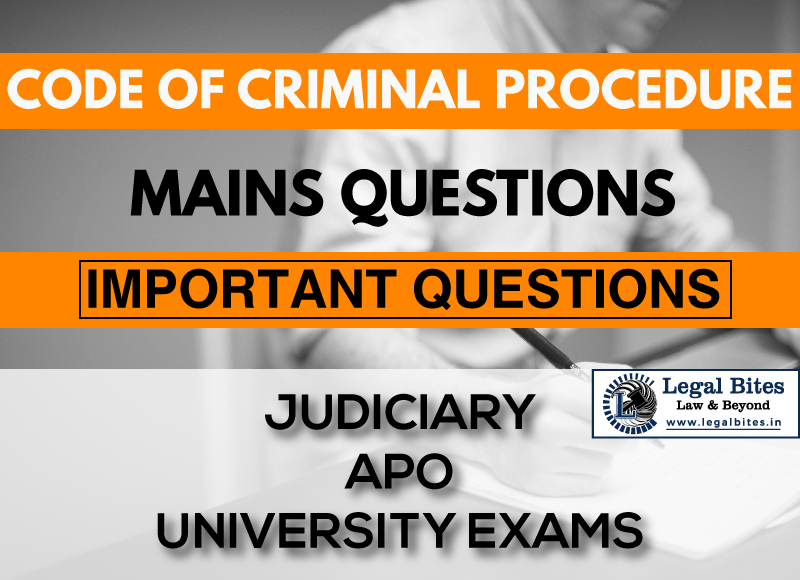State the procedure for disposal of property at the conclusion of the trial.
Such property can be disposed of in any of the four following ways: (1) destruction (2) confiscation (3) delivery to the person entitled to its possession or (4) otherwise.;

Question: State the procedure for disposal of property at the conclusion of the trial. Find the answer only on Legal Bites. [State the procedure for disposal of property at the conclusion of the trial.] Answer Decisions to dispose of or divest a property or an asset require in-depth examination and economic appraisal. The Code of Criminal Procedure prescribes the power to the courts pertaining to the disposal of properties which are in dispute. Section 452 of CrPC, 1973 deals with the...
Question: State the procedure for disposal of property at the conclusion of the trial.
Find the answer only on Legal Bites. [State the procedure for disposal of property at the conclusion of the trial.]
Answer
Decisions to dispose of or divest a property or an asset require in-depth examination and economic appraisal. The Code of Criminal Procedure prescribes the power to the courts pertaining to the disposal of properties which are in dispute. Section 452 of CrPC, 1973 deals with the order for disposal of property at the conclusion of the trial. The procedure related to the same is given in the following sub-sections of section 452:
(1) When an inquiry or trial in any Criminal Court is concluded, the Court may make such order as it thinks fit for the disposal by destruction, confiscation, or delivery to any person claiming to be entitled to possession thereof or otherwise of any property or document produced before it or in its custody, or regarding which any offence appears to have been committed, or which has been used for the commission of any offence.
(2) An order may be made under subsection (1) for the delivery of any property to any person claiming to be entitled to the possession thereof, without any condition or on the condition that he executes a bond, with or without sureties, to the satisfaction of the Court, engaging in restoring the such property to the Court if the order made under sub-section (1) is modified or set aside on appeal or revision.
(3) A Court of Session may, instead of itself making an order under subsection (1), direct the property to be delivered to the Chief Judicial Magistrate, who shall thereupon deal with it in the manner provided in sections 457, 458, and 459.
(4) Except where the property is livestock or is subject to speedy and natural decay, or where a bond has been executed in pursuance of sub-section (2) an order made under sub-section (1) shall not be carried out for two months, or when an appeal is presented until such appeal has been disposed of.
(5) In this section, the term” property” includes, in the case of property regarding which an offence appears to have been committed, not only such property as has been originally in the possession or under the control of any party, but also any property into or for which the same may have been converted or exchanged, and anything acquired by such conversion or exchange, whether immediately or otherwise.
The provisions of this section come into operation only at the conclusion of an inquiry or a trial in a Criminal Court. They refer to four classes of property or document:
(1) produced before the Court; or
(2) in its custody; or
(3) regarding which any offence is committed; or
(4) which is used in committing any offence.
Such property can be disposed of in any of the four following ways: (1) destruction (2) confiscation (3) delivery to the person entitled to its possession or (4) otherwise.
This section provides for the disposal of property at the conclusion of inquiry or trial, contemplates only one order by Criminal Court, and after it has passed that order and effect have been given to it by disposing of the property, the Court has no authority in law to pass another order in respect of that property, which is no longer before it or in its custody.
Where therefore, the property alleged to have been stolen was delivered to the complainant by order of the trial Court as well as the appellate Court. The accused, thereafter, applied for taking back the property from the complainant and its delivery to him (accused), it was held in Ghoor Mal (1952) Raj 559 that the property had already passed out of the custody of the Court, it had no jurisdiction to call back the property from the complainant and give it to the accused.
The provision in sub-section (2), for the imposition of condition or taking of bond is made to provide for the order being set aside in appeal or revision.
Important Mains/Long Questions for Judiciary, APO & University Exams


